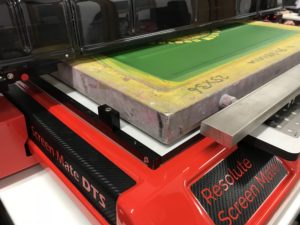
This month Resolute DTG’s managing director, Colin Marsh, explains the differences between DTG, screen and how the magic numbers where they meet have changed.
As the print run length of garments produced using the DTG process increases, the print runs produced with screen printing are rapidly reducing. Why is this?
As the cost of DTG inks reduces and the number of shirts produced per hour goes up the DTG process becomes more viable for longer print runs. On the flip side to this, with the cost of DTS (direct to screen) systems is reducing so do the screen printing press set-up times. This reduces the run lengths needed to make screen printing for complex designs more viable.
Although the profit margins are still the best for both processes when DTG is used for variable data or one offs, and screen printing still wins hands down when print runs get to 1,000 and above of the same design, the two processes now have a much wider range of print run lengths now with healthy margins.
In a race between DTG and screen printing today, the results compared to two years ago are quite eye opening. I have put together an example of three scenarios . I have based the costs on an average and also the number of prints per hour. These figures are not related to any particular brand or product, but they do assume DTS is used in conjunction with a pneumatic registration clamping system on an automatic screen press. The DTG printer will be producing 60 shirts an hour.
Job number 1: individual one off web generated orders
DTG wins 100% in this scenario, a single print on a dark T shirt with an A3 image can be produced in less than five minutes with an average consumable cost of less than £1.
Job number 2: 2000 prints of a complex design in six spot colours
Screen printing wins this one and here is why. Assuming the screen printer is using a DTS system configured to work alongside a modern screen press and clamping system, the six screens could be imaged, exposed, washed out and set-up on the press in around an hour. This assumes the mesh is already coated ready for imaging.
DTS eliminates the use of film positives and the need for manual alignment and spotting out. Once loaded onto the screen press, as the separations have been electronically registered not manually the set-up time is massively reduced. Halftones washout cleaner making the whole set-up process quicker, saving time which is of course is saving money.
A good average-sized automatic screen press can easily produce 600 shirts an hour with plenty of speed left if the job is urgent.
The 2000 shirts will be produced in half a day using this method and set-up. If we compare this job’s production time and costs using DTG, with a single machine you would be hard pushed to better production times of a couple of days with much higher consumable costs.
Job number 3: 200 dark shirts of the same design
This is where it gets interesting, taking into account the production figures are based around 60 shirts an hour for DTG and 600 shirts an hour for screen printing the 200 run now meets in the middle at virtually the same production costs.
The DTG printer starts producing 60 shirts an hour almost immediately; with no set-up time the total job will be finished in a little over three hours.
The screen printer needs to make six screens and set-up the press ready to run, once this is done the prints will take only half an hour.
This example almost meets in the middle and you could use either process to produce them with similar end results. There will be a few differences as there are advantages and disadvantages for each process.
The key points here are, two years ago the cost of DTS equipment was much higher making it impossible to compare costs. Without DTS the set-up time for screen printing took much longer and was more labour intensive.
The run length where both processes can be used at almost equal costs and production times now runs between 100 and 200, much better than two years ago.
 Printwear & Promotion The Total Promotional Package
Printwear & Promotion The Total Promotional Package




